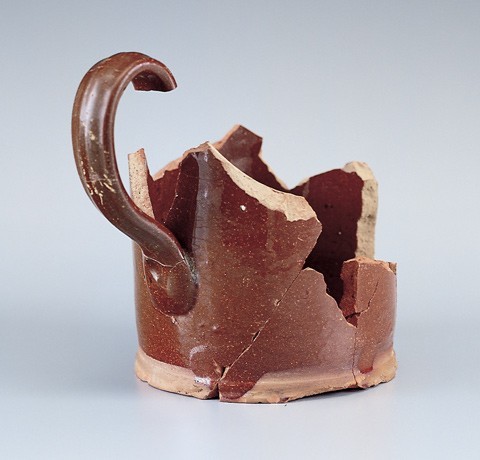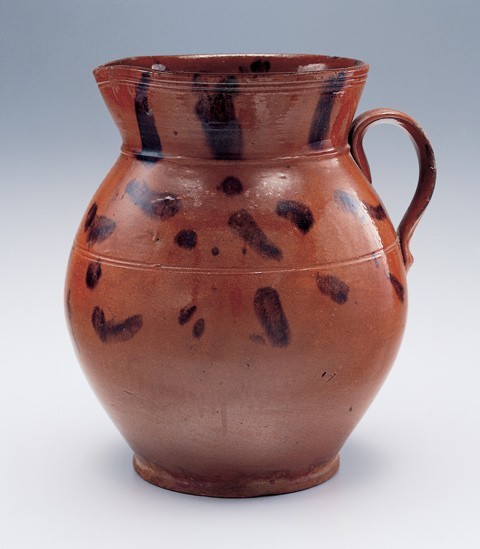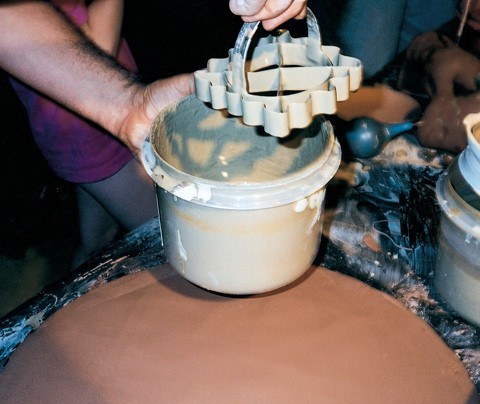
Jugs and flask, probably Huntington, New York, late eighteenth/ early nineteenth century. Manganese enriched lead-glazed earthenware. H. of tallest: 10 1/8". (All objects from the Anthony W. Butera, Jr. Collection; photos by Gavin Ashworth unless otherwise noted.) The attribution to Huntington is based on a jug that descended in a Huntington family. These objects are thought to date from the 1780s when Jonathan Titus owned the property until it sold on February 27, 1805. The lip on the flask matches the lips on the other two vessels. All three vessels were acquired locally. It should be noted that this kind of attribution is not foolproof; however, the importance of local knowledge and provenance becomes important when no other evidence is available.

Flasks, probably Huntington, New York, late eighteenth/early nineteenth century. Right: Manganese enriched lead-glazed earthenware. Left: Lead-glazed earthenware daubed with manganese oxide. H. of both: 7 1/8". The black-glazed flask fragment was discovered underneath the floor of a ca. 1810 house in Miller Place, Long Island. The lip of the flask is similar to several known Huntington vessels, including a straight-sided black manganese lead-glazed earthenware jar attributed to the Titus period in an early Huntington collection, and a rim waster found at the pottery site.

Mugs, probably Huntington, New York, 1805–1860. Lead-glazed earthenware daubed with manganese oxide. H. (left to right): 5 7/16", 6 1/2", and 3 15/16". This is a rare graduated group of tankards attributed to the Huntington pottery. The tankard on the far right came from a local source. The other two vessels did not, but both match the first almost perfectly. It is interesting to note the color difference which should not always be a guideline for attribution since the color of fired red earthenwares can be affected by conditions inside or outside the kiln, contaminants in the glaze, or different conditions of the clay source. The style of the extruded handles and their attachments has been found at the site of the Huntington pottery.

Mug fragment, probably Huntington, New York, 1805–1860. Lead-glazed earthenware daubed with manganese oxide. D. 3 1/2". This fragment of a tankard was found during the removal of a Victorian porch from a ca. 1680–1700 house in Mt. Sinai, Long Island. It is similar in all ways to the mugs illustrated in fig. 3. A similar tankard appears in the 1837 William Sydney Mount painting The Long Story.

Jugs and flask, probably Huntington, New York, 1805–1860. Lead-glazed earthenware daubed with manganese oxide. H. of tallest: 6 7/8". These three pots were purchased at auction from the Charles Embree Rockwell estate in Nissequogue, Smithtown, Long Island. This was a rare opportunity to purchase redware directly from a Long Island estate. The handle attachments are similar to the tankards illustrated in fig. 3. Also the same attachment of the handles on the jugs has been found at the pottery site. Although these examples are similar to wares produced at the Norwalk potteries, these pots have a local history and have been attributed to the Huntington pottery.

Porringers, possibly Huntington, New York, 1805–1860. Lead-glazed earthenware daubed with manganese oxide. H. 3 3/4" and 3 1/2". These two porringers are without any local provenance. However, identical handles have been found at the Huntington pottery site. Another example is in a local collection.

Syrup or oil jar, possibly Long Island, New York, ca. 1840. Lead-glazed earthenware daubed with manganese oxide. H. 8 1/2". Although this pot has a New England provenance, an identical extruded handle has been found at the Huntington pottery site. Two other pots of this form made in salt-glazed stoneware are known and are believed to be from the Hudson River Valley. The Huntington pottery shares a continuum with the Hudson River Valley potteries through the Caire and Brown families. Wet drug jars in continental tin-glazed earthenwares appear in this form.

Jar, attributed to Huntington, New York, 1805–1860. Lead-glazed earthenware daubed with manganese oxide. H. 8". This is a form traditionally attributed to Huntington.

Jar and lid, possibly Long Island, New York, 1805–1860. Lead-glazed earthenware daubed with manganese oxide. H. to top of lid. 10 5/8". Another variation on the form illustrated in fig. 8. It is possible that some of these pots were made in the Hudson River Valley, although there is no evidence yet to prove this.

Jar, possibly Long Island, New York, 1840–1860. Lead-glazed earthenware daubed with manganese oxide. H. 8 3/4". This jar descended in a Riverhead, Long Island, family and was found with a salt-glazed stoneware butter churn bearing the mark of Fredrick J. Caire Huntington who came to Huntington in the 1840s.

Jar, possibly Long Island, New York, 1805–1860. Lead-glazed earthenware daubed with manganese oxide. H. 8 1/2". This pot came from a collection formed on Long Island in the 1950s. It is slightly smaller than the jar illustrated in fig. 10, making the two pots look different at first glance. Further examination reveals similar features, and it is possible that they both were made by the same potter.

Jug, probably Long Island, New York, 1835–1860. Lead-glazed earthenware daubed with manganese oxide. H. 10". This handled jug comes from an early Setauket, Long Island, collection formed before 1950. A handled jug of this form appears in the painting illustrated in fig. 13. Traditionally, collectors of American pottery have believed that this form was produced later. This painting establishes an earlier date.

William Sydney Mount, Truant Gamblers (Undutiful Boys), 1835. Oil on canvas. 24" x 30". (Courtesy, New-York Historical Society, acc. no. 1858.)

Flask, probably Huntington, New York, 1835–1860. Lead-glazed earthenware daubed with manganese. H. 8". This flask has the same lip as the jug illustrated in fig. 12 . Although glaze should not always be used as a guideline for attribution, it sometimes helps when a group of wares are compared. This flask was found concealed in the wall of a house in the Port Jefferson area.

Jar, possibly Long Island, New York, 1805–1860. Lead-glazed earthenware daubed with manganese oxide. H. 9 1/2". This jar has a credible Long Island provenance.

Pitcher, possibly Huntington, New York, 1805–1860. Lead-glazed earthenware daubed with manganese oxide. H. 9 1/2". The form, color, and decoration of this pitcher are similar to the jar illustrated in fig. 15. The pitcher’s extruded handle has been found at the pottery site.

Jar and lid, probably Long Island, New York, 1805–1860. Lead-glazed earthenware daubed with manganese oxide. H. to top of lid 10 1/2". This jar came from an early collection formed in Port Jefferson. It was found together with a straight-sided jar probably made by the same potter.

Pitcher, possibly Huntington, New York, 1805–1860. Lead-glazed earthenware daubed with manganese oxide. H. 10 1/8". This pitcher has been attributed to Huntington on the fact that this type of extruded handle and its attachment have been found at the pottery site. The belly of the pitcher also matches the belly of the pot in fig. 17, suggesting that the two were made by the same potter. Another pitcher of a different form, but with the same handle and attachment, appears in the painting illustrated in fig. 19.

Shepard Alonzo Mount, The Breakfast Call, 1852. Oil on canvas. 24" x 30". (Courtesy, Long Island Museum of American Art, History and Carriages; gift of Mr. and Mrs. Ward Melville, 1976.)

Bowl and archaeological fragment, Huntington, New York, 1805–1860. Lead-glazed earthenware daubed with manganese oxide. D. 13". Wasters of these bowls have been found at the pottery site. Matching rims have also been found along with the kiln furniture needed to stack the bowls in the kiln. Sherds of these bowls have also been found in Port Jefferson and Mt. Sinai, Long Island.

Bowl, Huntington, New York, 1805–1809. Lead-glazed earthenware daubed with manganese. D. 5 5/8". Two other examples of this form are owned by the Huntington Historical Society. This is a technically difficult form to produce. The small bowl has been thrown on a wheel, probably bisque fired, decorated, glazed on both sides then fired perhaps in a saggar. This form may be a tobacco dish, which is listed as one of the most expensive forms that Samuel J. Wetmore and Company produced ca. 1808–1809.

Dish, Huntington, New York, 1805–1860. Lead-glazed earthenware with slip decoration. D. 13 1/4". The slip decoration on this plate matches the cobalt blue decoration on a salt-glazed stoneware pot that descended in the Brown family and was probably made in Huntington before the Brown’s ownership. It is interesting to find a decorator who worked on stoneware and redware. Although the condition of this plate is poor, the large size and decoration are quite rare.

Loaf dish, Huntington, New York, 1805–1860. Lead-glazed earthenware with slip decoration. L. 14 3/8". This is another variation by the same decorator who ornamented the dish illustrated in fig. 22. The central curvilinear design occurs in cobalt on salt-glazed stoneware from the pottery site. The feather type design on the top and bottom of the loaf dish have been found at the pottery site in slipware and cobalt blue salt-glazed stoneware. A signed F. Caire Huntington stoneware jug in a private collection has a similar design. This loaf dish was recently discovered in a barn on Long Island.

Loaf dish, Huntington, New York, 1805–1860. Slip-decorated lead-glazed earthenware. L. 11 3/16". This loaf dish is decorated by the same skilled decorator who applied the slip on the dishes illustrated in figs. 22 and 23. Much practice is needed to execute these designs, as the slip tends to clog and has to be mixed frequently.

Loaf dish, Huntington, New York, ca. 1840–1860. Lead-glazed earthenware with slip decoration. L. 11 1/2". This stamped pattern was found at the pottery site.

Demonstration by Greg Shooner of the stamping techniques used to decorate Huntington redware. (Photo, Anthony W. Butera, Jr.) This tin stamp was fashioned during the annual ceramics conference at Eastfield Village. Here the stamp is being dipped into white slip.

A series of stampings applied to a red clay slab illustrating the speed and repetitive nature of this method of slip decorating. (Photo, Anthony W. Butera, Jr.)

Border tile, England, fourteenth century. Earthenware. L. 4 3/4".

Jug, Britain, ca. 1840. Whiteware. H. 6". The star-like slip decoration has been applied with a stamp in a manner analogous to the Huntington pottery examples.

Loaf dish, Huntington, New York, 1840–1885. Lead-glazed earthenware with slip decoration. L. 14 1/2". Only two loaf dishes with this stamped design survive. This pattern has been found at the Huntington pottery site.

Dish, Huntington, New York, 1840–1885. Lead-glazed earthenware with slip decoration. D. 12". The slip may be lighter from using the stamp repeatedly without redipping in the slip. This would increase decorating speed and conserve slip.

Loaf dish, Huntington, New York, 1840–1885. Lead-glazed earthenware with slip decoration. L. 12 7/8". This loaf dish and all other plates with the stamped star design have some sort of staining or muddiness in the glaze. This muddiness also appears commonly on other Huntington stamped patterns. This effect may have occurred through contamination due to experimentation with glazes or from the making of Rockingham-type glazed pots. Fragments of Rebekah-at-the-Well teapots have been found at the site including parts of saggars associated with their manufacture.

Plate, Huntington, New York, 1840–1885. Lead-glazed earthenware with slip decoration. D. 8". This is a stamped pattern found at the pottery site. The design is identical to the plate illustrated in fig. 36 with the exception of the circle in the design. This could be explained by either the addition or removal of the circle from the tin stamp. The plate is a rare small size and was bought at a local auction from a Long Island estate.

Dish, Huntington, New York, 1840–1885. Lead-glazed earthenware with slip decoration. D. 13". Example of a stamped design found at the pottery site in a very rare large size.

Plate, Huntington, New York, 1840–1885. Lead-glazed earthenware with slip decoration. D. 9 7/8". Like the loaf dish illustrated in fig. 32, this plate has staining in the glaze, which is typical of plates with the stamped star design. In addition, the clay used in this plate has an agateware look. This may have been clay left over from the manufacture of a “variegated” ware. Sherds of a scroddled-type ware have been found at the site.

Plates, Huntington, New York, 1840–1888. Lead-glazed earthenware with slip decoration. D. of all: 10 1/8". These three plates with a stamped design were probably made on the same mold.

Plates, Huntington, New York, 1840–1888. Lead-glazed earthenware with slip decoration. D. of all: 10 1/8". These three plates with a stamped design were probably made on the same mold.

Plates, Huntington, New York, 1840–1888. Lead-glazed earthenware with slip decoration. D. of all: 10 1/8". These three plates with a stamped design were probably made on the same mold.

Plates, New England, 1840– 1885. Lead-glazed earthenware with slip decoration. D. 10 3/4" and 9 1/8". Much caution must be used in attributing all stamped plates to Huntington. The designs on these two plates have not been found at the Huntington pottery site. They could have been made at one of the Norwalk potteries. In this collection there are other examples of plates with stamped designs which have not come from Huntington or Norwalk. Stamping technology surely must have been used at other American potteries from the same period.

Plates, New England, 1840– 1885. Lead-glazed earthenware with slip decoration. D. 10 3/4" and 9 1/8". Much caution must be used in attributing all stamped plates to Huntington. The designs on these two plates have not been found at the Huntington pottery site. They could have been made at one of the Norwalk potteries. In this collection there are other examples of plates with stamped designs which have not come from Huntington or Norwalk. Stamping technology surely must have been used at other American potteries from the same period.

Plate, Huntington, New York, 1851–1885. Lead-glazed earthenware with slip decoration. D. 8". This plate, along with another plate of the same size in a Long Island collection which says “Long Island,” has been attributed to the Huntington pottery. The “Nettie” plate was purchased at auction with a salt-glazed stoneware pot having the Brown Brother mark ca. 1870–1885. The stoneware jar was decorated with the word “Butter” in the same distinctive script that appears on this redware example in cobalt blue.

Dish, Huntington, New York, ca. 1851–1885. Lead-glazed earthenware with slip decoration. D. 11 1/2". Flying Cloud was a famous clipper ship launched on April 15, 1851. Another slip-decorated plate by the same decorator with the name “America” is in the Nina Fletcher Little collection. The latter plate commemorates the schooner for which the America’s Cup race was named. The sails for the America were made in Port Jefferson by Reuben H. Wilson. George Brown, the last owner of the Huntington pottery, was an original member of the local yacht club and built and sailed boats.

Anthony W. Butera, Jr.
